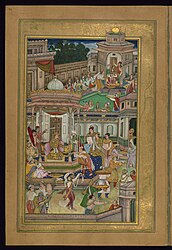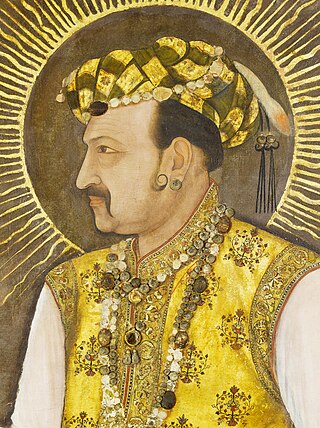
Nur-ud-Din Muhammad Salim, known by his imperial name Jahangir, was the fourth Mughal Emperor, who ruled from 1605 till his death in 1627.

Ustad Mansur was a seventeenth-century Indian painter and naturalist who served as a Mughal court artist. During which period he excelled at depicting plants and animals. He was the earliest artist to depict the dodo in colour, apart from being the first to illustrate the Siberian crane. Towards the end of Akbar's reign, he gained the title of ustad (master) and during the reign of Mughal Emperor Jahangir his masterpieces earned him the title of Nãdir-al-’Asr. Although he was largely known for his natural history illustrations, he also portrayed people in various manuscript illustrations.

Mughal painting is a South Asian style of painting on paper confined to miniatures either as book illustrations or as single works to be kept in albums (muraqqa), originating from the territory of the Mughal Empire in the Indian subcontinent. It emerged from Persian miniature painting and developed in the court of the Mughal Empire of the 16th to 18th centuries. Battles, legendary stories, hunting scenes, wildlife, royal life, mythology, as well as other subjects have all been frequently depicted in paintings.

Indian painting has a very long tradition and history in Indian art. The earliest Indian paintings were the rock paintings of prehistoric times, such as the petroglyphs found in places like the Bhimbetka rock shelters. Some of the Stone Age rock paintings found among the Bhimbetka rock shelters are approximately 10,000 years old. Because of the climatic conditions in the Indian subcontinent, very few early examples survive today.

The Akbarnama, is the official chronicle of the reign of Akbar, the third Mughal Emperor, commissioned by Akbar himself and written by his court historian and biographer, Abul Fazl. It was written in Persian, which was the literary language of the Mughals, and includes vivid and detailed descriptions of his life and times. It followed the Baburnama, the more personal memoir by his grandfather, Babur, founder of the dynasty. It was produced in the form of lavishly illustrated manuscripts.

Mariam-uz-Zamani ;, commonly known by the misnomer Jodha Bai, was the chief consort and principal Hindu wife as well as the favourite wife of the third Mughal emperor, Akbar. She was also the longest-serving Hindu empress of the Mughal Empire with a tenure of forty-one years (1562–1605).

Tutinama, literal meaning "Tales of a Parrot", is a 14th-century series of 52 stories in Persian. The work remains well-known largely because of a number of lavishly illustrated manuscripts, especially a version containing 250 miniature paintings commissioned by the Mughal Emperor Akbar in the 1550s. The Persian text used was edited in the 14th century from an earlier anthology ‘Seventy Tales of the Parrot’ in Sanskrit compiled under the title Śukasaptati dated to the 12th century. In India, parrots are popular as storytellers in works of fiction.

Farrukh Beg, also known as Farrukh Husayn, was a Persian miniature painter, who spent a bulk of his career in Safavid Iran and Mughal India, praised by Mughal Emperor Jahangir as "unrivaled in the age."

'Abd al-Ṣamad or Khwaja 'Abd-us-Ṣamad was a 16th century painter of Persian miniatures who moved to India and became one of the founding masters of the Mughal miniature tradition, and later the holder of a number of senior administrative roles. 'Abd's career under the Mughals, from about 1550 to 1595, is relatively well documented, and a number of paintings are authorised to him from this period. From about 1572 he headed the imperial workshop of the Emperor Akbar and "it was under his guidance that Mughal style came to maturity". It has recently been contended by a leading specialist, Barbara Brend, that Samad is the same person as Mirza Ali, a Persian artist whose documented career seems to end at the same time as Abd al-Samad appears working for the Mughals.

Basāwan, or Basāvan, was an Indian miniature painter in the Mughal style. He was known by his contemporaries as a skilled colorist and keen observer of human nature, and for his use of portraiture in the illustrations of Akbarnama, Mughal Emperor, Akbar's official Biography, which is seen as an innovation in Indian art.
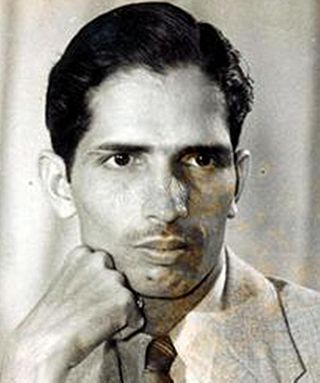
Kattingeri Krishna Hebbar was an Indian painter and art educator. He is well known for his paintings that captured the social life of the common people in India. Inspired by traditional Indian art, he combined the Western art techniques with his paintings to create a unique style of his own. Painting for Hebbar was about being true to the original self and this is what he tried to achieve in his works. In addition to his paintings, he is also known for his rhythmic line drawings and illustrations.

Judaai (transl. Separation) is a 1980 Indian Hindi-language drama film, produced by A.V. Subba Rao under the Prasad Art Pictures banner and directed by T. Rama Rao. The film stars Jeetendra and Rekha, with music composed by Laxmikant–Pyarelal. It is a remake of the Telugu film Aalu Magalu (1977).

Deccan painting or Deccani painting is the form of Indian miniature painting produced in the Deccan region of Central India, in the various Muslim capitals of the Deccan sultanates that emerged from the break-up of the Bahmani Sultanate by 1520. These were Bijapur, Golkonda, Ahmadnagar, Bidar, and Berar. The main period was between the late 16th century and the mid-17th, with something of a revival in the mid-18th century, by then centred on Hyderabad.

Mughal karkhanas were the manufacturing houses and workshops for craftsmen, established by the Mughals in their empire. Karkhana is a Hindustani language word that means factory. These karkhanas were small manufacturing units for various arts and crafts as well as for the emperor's household and military needs. karkhanas were named and classified based on the nature of the job. For example, 'Rangkhana' and 'Chhapakhana' were for textile dyeing and printing work. The term 'tushak-khana' was used to describe workshops that made shawls and embellished them with embroidery or needlework. Imperial or Royal Karkhanas were for luxury goods and weapons. The karkhanas were the place for various production activities and also for the exploration of new techniques and innovations. Some operations such as weaving, embroidery work, and brocade work were often done under one roof, resembling an integrated assembly line.
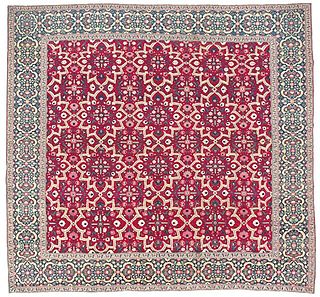
Mughal carpets were the handwoven floor coverings used in the Mughal Empire in their courts. Mughal carpets and rugs have their roots in India since the 16th and 17th centuries. Mughal carpets were a blend of Persian and Indian artistry uniquely designed with scenic landscapes, floral, and animal patterns. Kashmir was producing the finest wool and silk carpets and rugs, including prayer rugs. Sometimes the knot density in these rugs was so fine and tight as 300 knots per square centimeter.
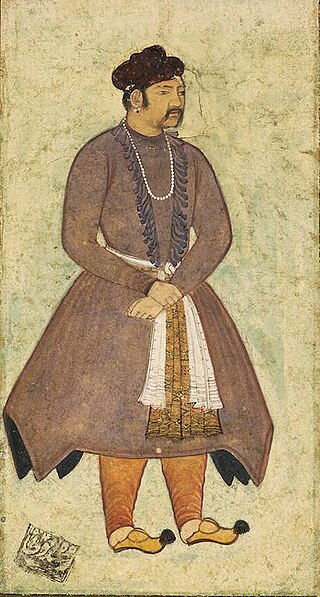
Katzeb was an article of dress encircling the body, at the waist with ends hanging in the front. It was a kind of sash also called Patka.
Chautar or Chaotaer is an old cotton fabric of the Mughal period. The chautar was a mulmul variety, and the finest mulmul was termed as "Mulmul Shahi" in Hindi and Persian languages. It was produced in Eastern India. Way back, Chittagong was exporting this cloth. Conceivably then cloths were produced in smaller pieces only since the Chautar is described as a piece good. It has been recorded with specific dimensions, i.e., length 12.44 meters and width 77.75 centimeters. Chautar was compared with sansuo, which was a three shuttle cloth, type of fine cotton variety produced at Songjiang.
James Vere Stewart Wilkinson (1885-1957) was a specialist in Persian manuscripts and miniature paintings at the British Museum.
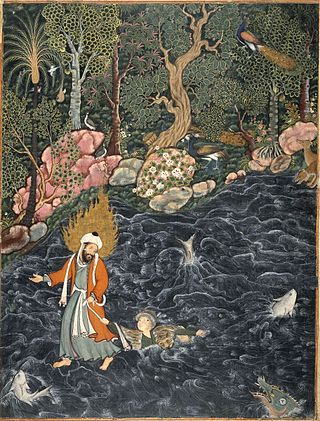
The Akbar Hamzanama is an enormous illustrated manuscript, now fragmentary, of the Persian epic Hamzanama commissioned by the Mughal emperor Akbar around 1562.

Nanha, also called Nanah or Nana, was an Indian painter and illuminator of the Mughal era, active during the reigns of emperors Akbar the Great, Jahangir and Shah Jahan.

